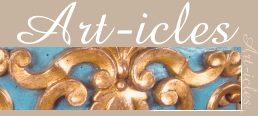      
|

Venetian Lacquer (date : 30 August 2001), from Agathe Parenty Beginning at the end of the 17th century, the spread of oriental products, notably Japanese - porcelain, silk, lacquer - influenced European decorative arts. Thus, before 1650 the Princess of Orange (Netherlands) owned a cabinet 'clad' with Japanese lacquer. Italy, partly due to Venice being at the terminus of the Silk Route did not escape this craze. The rarity of oriental lacquer, its climatic instability and difficult utilisation - the rigid resin panels adapted badly to the curves of marble - forced Europeans to synthesise this technique. Several processes, mostly based on varnish, were conceived. The merchant companies fixed the price of oriental lacquer but the growing demand caused prices to climb. Thus, a small gilded box from Japan, set with mother-of-pearl and exported by an English company, sold for between four pounds five shillings and five pounds in 1607, and cost seventeen pounds in 1611. So the importing countries set to making lacquer substitutes. Maximilien Mason noted in 1668 that "the lacquer from Venice is well known in reputation; there are all sorts of prices." In 1720 Filippo Bonani, in his 'Tratatto sopra la vernice detta communete cinese' numbers ten different kinds of lacquer, used by the English, French, Germans, Polish and Italians. According to Alvar Gonzales Palacios' book on art, Venetian lacquer probably appeared just after the middle of the 17th century, the date attributed to one of the oldest Venetian pieces, a pair of Moretti (Negro figures) from Ham House, entered in an inventory of 1669. The costliest technique, and the longest, consists of fixing muslin soaked in a stiffening fluid, to a marble chassis, usually resinous. Then the item of furniture is coloured with black, red or green softened with glue (using a technique called 'mordant' to stabilise the tint) and decorated with gilded chinoiserie. Finally, the craftsman applies two or three coats of sandarac (Arabic gum) which is worked differently to Chinese resin. The Ca' Reezzonoico (Venice) has kept a chest of drawers of this type. Dating from 1750, it is in carved and lacquered wood with oriental motifs and flower compositions in gilded relief on a black background inside a rococo frame. In order to compete with this technique at a better price, 'la lacca alla povera' or la lacca contraffata', more commonly known as 'arte povera' (i.e. poor lacquer) started to appear in certain towns. However, Venetian craftsman remained the most skilful. There is a tendency to group together all regional variations under the common heading of Venetian lacquer. Lacquering which is typically Venetian - 'Mobili Laguna' or 'Venezia d'Aqua' owes its quality to the strictness of the Guild. Elsewhere, this detailed control seems to have been less constant. Genoese production is characterised by the extremely fine coat of sandarac which leaves the wood visible. 'Lacca Contraffata' is a quick process where the craftsman applies motifs taken from contemporary engravings. The printer Remondini from Bassano del Grappa was the principal supplier to the workshops. These engravings were taken form the most popular catalogues, so certain decorations were inspired by the work of contemporary artists such as Ricci, Zaiss, Zucarelli, Anigoni, Waquer and Dall'Acqua. If, at the start, the iconography remained influenced by Asia (pagodas, mandarins, warriors, Tartar princesses, dragons and exotic animals) it became westernised as it evolved; plant motifs, rural scenes, sometimes inspired by Canaletto and by Zaiss, or religous themes. White lacquers, set off by green, by gilding or by other coloured tints are particular to Venice. The museums of Castello Sforezesco have kept an excellent example of a pier glass in poplar (early 18th century) decorated with rustic scenes. It should be noted that the interior of the marble is also lacquered. These highly prized pieces of painted furniture, known by the name 'lacca', brightened up 18th century interiors. The 'lacca contraffata' was used to furnish secondary residences, as opposed to 'real' pieces which were put in rooms used more frequently. All sorts of furniture was treated with this preparation; chests of drawers, armoires, desks, harpsichords, bedside cabinets, etc…, or rooms like at the Palazzo Reale (Rome) in 1732, based on an idea of the architect Filippo Juvarra. |
  |
|||
|
|||||